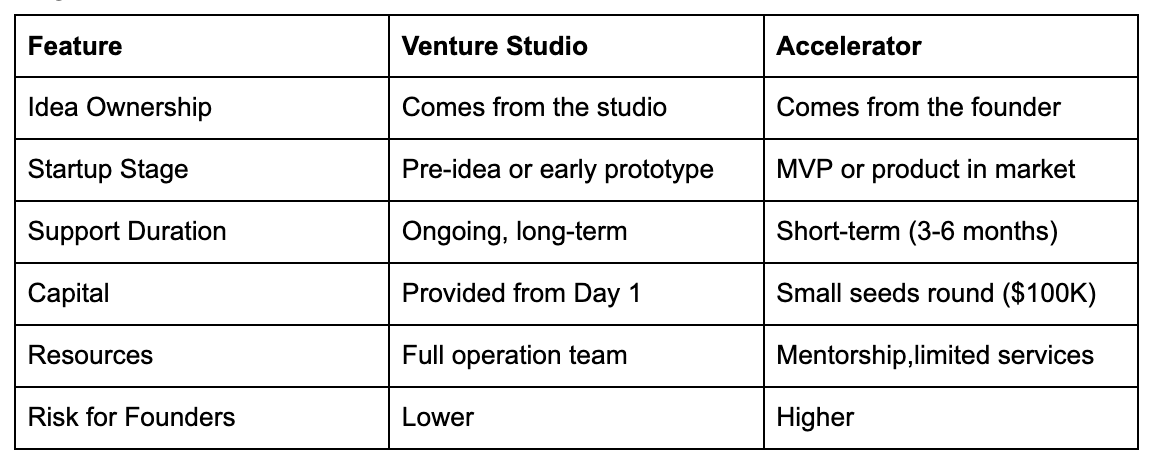Over the past decade, the Middle East and North Africa (MENA) region has been quietly, and rapidly, transforming from an oil-dependent economy into a hub of digital innovation. Ambitious government visions, rising investment flows, and a young, tech-savvy population have turned the region into fertile ground for entrepreneurship.
Now, a new model of innovation is taking root: venture building, the systematic creation of startups from within specialized organizations known as venture studios. Unlike traditional investors, venture studios don’t just fund startups; they build them from scratch, combining capital, talent, and operational expertise under one roof.
The question is no longer if this model will thrive in MENA, but how far it can go. Could the region become the world’s next epicenter for venture building?
The Rise of Venture Building in MENA
Historically, MENA’s economic landscape has been dominated by energy, real estate, and traditional trade. But in recent years, governments have recognized that true resilience depends on diversification and innovation. Initiatives such as Saudi Vision 2030, UAE Vision 2031, and Egypt Vision 2030 have placed entrepreneurship at the heart of national development.
Venture studios are emerging as a cornerstone of this new economy. By combining the precision of corporate strategy with the creativity of entrepreneurship, they are reshaping how startups are born and scaled.
In cities like Dubai, Riyadh, Cairo, and Manama, venture studios are now acting as innovation factories, producing startups faster, cheaper, and with higher survival rates than traditional methods.
Why the Venture Studio Model Works for MENA
The venture studio model fits the MENA region in ways that go beyond economic logic. It aligns with both the region’s structural strengths and its cultural realities.
Here’s why it’s taking off:
1. Government-Backed Innovation Ecosystems
Governments across MENA are actively investing in startup infrastructure, from Saudi Arabia’s Monsha’at and NEOM’s innovation programs to the UAE’s Dubai Future Foundation and Hub71 in Abu Dhabi.
These initiatives provide fertile ground for studios to thrive by connecting them with funding, talent, and regulatory support.
2. Access to Capital
The region has seen a surge in venture capital activity. According to Magnitt, venture funding in MENA surpassed $2.6 billion in 2024, with growing interest from sovereign wealth funds and family offices.
Venture studios benefit from this liquidity while offering investors lower risk and higher control, since they directly shape their startups from day one.
3. Talent Meets Vision
With one of the world’s youngest populations, nearly 60% under the age of 30, MENA is rich in creative, tech-savvy talent. Studios provide structure and mentorship to this pool of energy, channeling youthful ambition into scalable, globally competitive startups.
4. Cultural Fit for Collaboration
The collaborative nature of venture building aligns with the region’s culture of partnership and collective growth. The model encourages cooperation between governments, corporates, and founders, creating a shared sense of ownership over innovation.
The Building Blocks of MENA’s Venture Ecosystem
MENA’s venture ecosystem is now supported by a growing network of specialized studios, accelerators, and corporate innovation arms. Each plays a unique role in transforming the region into a global venture-building hub.
Enhance Ventures (UAE): One of the region’s leading studios, focused on digital platforms and consumer tech, creating and scaling ventures across GCC markets.
Astrolabs (Saudi Arabia): Blends talent development, corporate innovation, and startup incubation, acting as a bridge between local entrepreneurs and global markets.
Modus Capital (Egypt/UAE): Operates a hybrid model combining venture capital and studio services, helping early-stage startups validate and scale.
Flat6Labs (Bahrain & Egypt): Pioneers in seed acceleration that are now integrating venture-building elements into their programs.
These organizations are helping build a connected ecosystem, where ideas, funding, and talent move freely across borders.
From Oil to Code: The Strategic Transformation
The phrase “From sand to systems” captures the essence of MENA’s evolution. What once powered global economies through oil is now giving way to digital infrastructure, smart industries, and knowledge economies.
Venture studios are playing a crucial role in this shift. They enable the region to:
Build locally relevant, globally scalable startups.
Capture more value from innovation within regional markets.
Create sustainable jobs that align with the demands of a digital economy.
In essence, venture studios are industrializing entrepreneurship, applying the same systems thinking that once drove the region’s energy boom, but this time in the digital realm.
Challenges Along the Way
Of course, the journey is not without hurdles. For MENA to become a true global hub for venture building, several challenges must be addressed:
Regulatory Diversity: Each country has its own startup and investment laws, making cross-border scaling complex.
Talent Retention: Many skilled professionals still migrate to Europe or North America for better opportunities.
Corporate Mindset: Some legacy organizations are still hesitant to take the calculated risks that venture studios require.
However, these challenges are being actively tackled through policy reforms, regional collaboration, and corporate innovation programs, a sign that the region’s trajectory is heading firmly upward.
Global Relevance and Future Potential
Globally, venture studios are gaining traction, from Atomic and Science Inc. in the U.S. to Rocket Internet in Europe. What sets MENA apart is the combination of youthful energy, government commitment, and capital availability.
If nurtured correctly, MENA’s venture ecosystem could soon rival Silicon Valley’s startup engine, offering a new blueprint for emerging markets. With its strategic location bridging Africa, Asia, and Europe, the region has the potential to become a launchpad for global innovation.
Final Thought: Building the Future, One Venture at a Time
The MENA region is proving that innovation doesn’t have to follow the Silicon Valley playbook. By adapting global best practices to local realities, it’s pioneering a new model for venture creation, one rooted in collaboration, sustainability, and scale.
From Riyadh to Cairo, from Dubai to Casablanca, venture studios are not just launching startups; they are building systems of innovation that will define the region’s economic future.
What began in the sand is now evolving into a sophisticated ecosystem, from sand to systems, from oil to ideas.
And if the momentum continues, the MENA region may soon stand not just as a participant in global innovation, but as its next great hub.

























